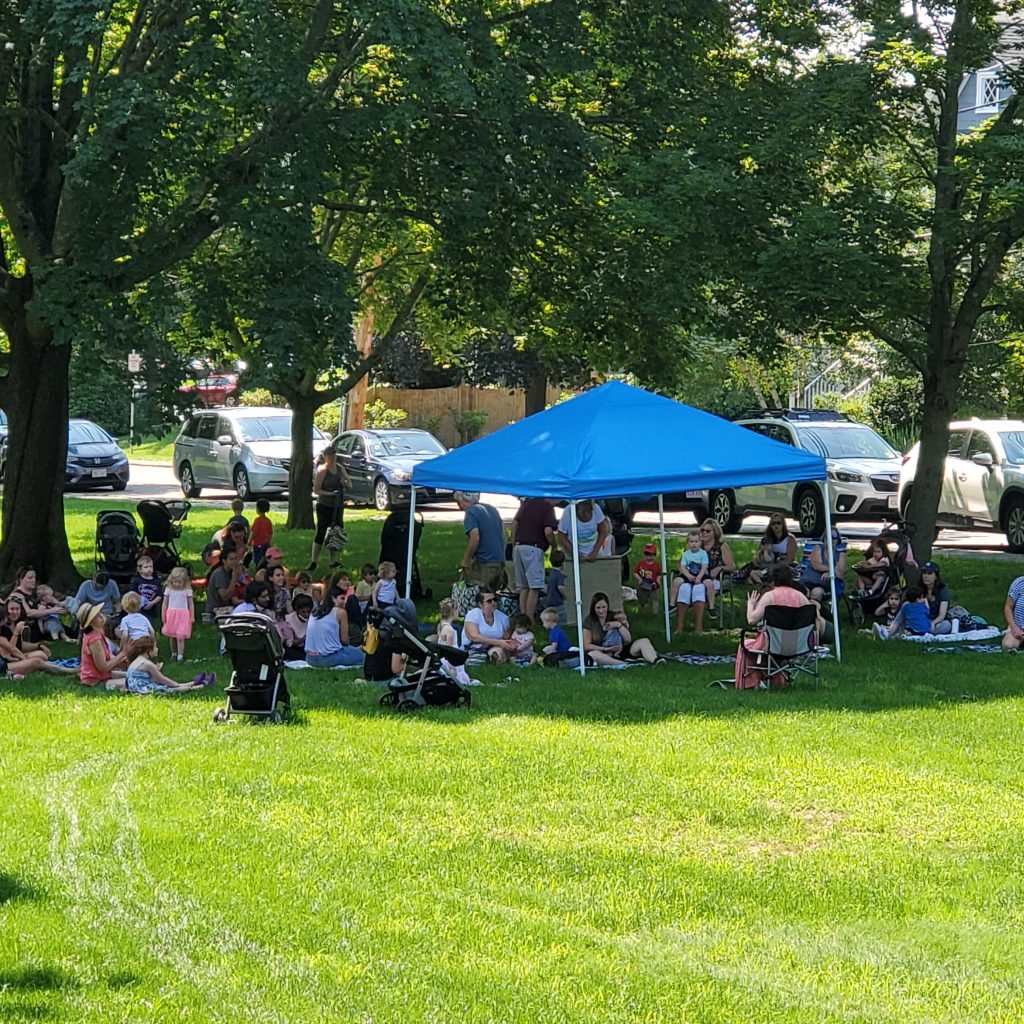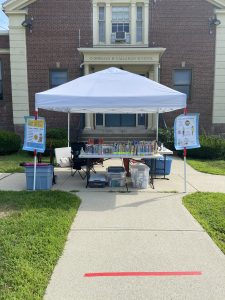
Looking for creative ideas to expand library programs and services outdoors? In this interview, Kate Tigue, Head of Youth Services at the Morrill Memorial Library in Norwood, tells us about the many ways the library successfully moved programs and services outdoors during the pandemic, as well as, the library’s plans for future use of the outdoors. This is the finale in a series of four interviews featuring how public libraries evolved during the pandemic by moving services and programs outdoors.
Tell us about how the Morrill Memorial Library expanded services and programs to the outdoors.
 Kate Tigue: The library had to get creative during the pandemic and find a way to offer safe programs to our patrons outside of our building when our hours and services were very restricted. We also faced the added challenge of not actually having any green space around our building where we could facilitate outdoor activities. The staff was growing increasingly concerned that children did not have adequate access to reading materials during remote learning. We reached out to the Norwood Public Schools and created a partnership to bring an outdoor pop-up library experience to neighborhood schools around town so families could get books safely. Pop-Up Library became a weekly event that kids and families looked forward to visiting to choose their own reading materials and socialize with the staff. It was a great way to get out of the building during the good weather and still show our community that the library was there for them. We even added a pop-up library aimed at adults during our town’s popular outdoor summer concert series and at a local brewery that were both very successful!
Kate Tigue: The library had to get creative during the pandemic and find a way to offer safe programs to our patrons outside of our building when our hours and services were very restricted. We also faced the added challenge of not actually having any green space around our building where we could facilitate outdoor activities. The staff was growing increasingly concerned that children did not have adequate access to reading materials during remote learning. We reached out to the Norwood Public Schools and created a partnership to bring an outdoor pop-up library experience to neighborhood schools around town so families could get books safely. Pop-Up Library became a weekly event that kids and families looked forward to visiting to choose their own reading materials and socialize with the staff. It was a great way to get out of the building during the good weather and still show our community that the library was there for them. We even added a pop-up library aimed at adults during our town’s popular outdoor summer concert series and at a local brewery that were both very successful!
How did your community respond to outdoor library services and programs?
Kate Tigue: Our patrons loved seeing the library staff outside of the building! We ended up doing more pop-ups through the fall after families asked us to find a way to make more outdoor programming available. The library turned to our amazing community partners and fellow town departments to help us find new spaces to meet patrons. We worked with our Recreation Department to create an outdoor story time at a popular playground. Families would set up picnic blankets, attend story time, and then meet up so children could play together afterwards at the playground. We also worked with our local Coordinated Family and Community Engagement grant program to offer a process art program for kids on the grounds of CFCE’s facility. Parents and kids loved being outdoors and doing a messy activity without worry. During every outdoor program, patrons let the staff know that they really enjoyed seeing the library offer services and fun programs outside of our building and hoped the library would continue to offer similar programs in the future.

What are your library’s plans for future use of the outdoors?

Kate: We plan to make outdoor programs a regular feature of library service during the good weather, even though the library is open for regular business hours. The existence of these programs prompted the library to purchase some items to make outdoor programming easier for staff and patrons. We purchased a mobile PA system so librarians could accommodate a large group at storytime near a busy road. We also purchased a pop-up canopy, a new wi-fi hotspot for staff use, and other equipment to enable Pop-Up Library to become a permanent service the library can offer in multiple settings. Since our community partners and other town departments know we can now offer services outside of our building, the library has been invited to plan and participate in more community events, like the upcoming Norwood Earth Day Fair in 2022.
What lessons did you learn that may be helpful for other libraries?
Kate: You can do outdoor programming even if your library doesn’t have its own green space! Forging community partnerships is not only a great way to find outdoor areas for programs but also a way to increase the library’s reach in the future. Outdoor programming offers patrons a chance to encounter the library in unique ways and it helps build the library’s reputation as a flexible, vital service that’s willing to expand its traditional role to meet the changing needs of the community. On the logistical side of things, we had to learn to plan our staff time more effectively. There’s a lot more physical effort needed when you provide programs outdoors at an offsite location. We needed buy-in and help from nearly every library department in order to be successful. We also found it helpful to let go of a perfectionist mindset when it came to outdoor programming. Things might go wrong. The weather might not cooperate! Technology will fail. Even when those things happened, our patrons were totally understanding and just thrilled that we were out and about.
Any final thoughts?
Kate: Outdoor programming turned out to be an unexpected way for the library to build new relationships and strengthen established partnerships in Norwood. The pandemic has been difficult for many folks in our town and library staff really worried about our patrons during such an isolating time. Coming together with other town departments to reach people really gave us a renewed sense of purpose during a time when it was easy to feel helpless. Trying “out of the box” ideas when it came to brainstorming programming locations was also incredibly invigorating for the staff. Outdoor programming has changed the way we think about library services and we are really excited about the new possibilities for community outreach!
Interview with Kate Tigue, Head of Youth Services, Morrill Memorial Library, Norwood
Interviewed by Michelle Eberle, Consultant, Massachusetts Library System
Photo Credits: Kate Tigue, Hilary Umbreit, Nicole Guerra-Coon, Clayton Cheever (all MML staff)


